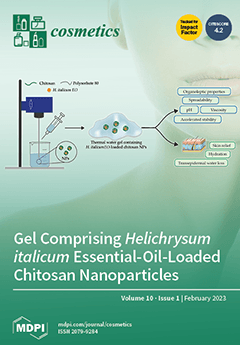Nostoc verrucosum, an edible microalgal species, forms colonies in streams. Here, we investigated the antimelanogenic and anti-oxidative effects of
N. verrucosum extracts. We collected
N. verrucosum from Toyama Prefecture, Japan, and successfully cultured it in indoor cultivation systems. Aqueous, methanol, and hexane
[...] Read more.
Nostoc verrucosum, an edible microalgal species, forms colonies in streams. Here, we investigated the antimelanogenic and anti-oxidative effects of
N. verrucosum extracts. We collected
N. verrucosum from Toyama Prefecture, Japan, and successfully cultured it in indoor cultivation systems. Aqueous, methanol, and hexane extracts of
N. verrucosum were prepared for various experiments. To elucidate the antimelanogenic effects of
N. verrucosum, we performed tyrosinase assay, melanin content assay, western blotting, and real-time quantitative reverse-transcription polymerase chain reaction (qRT-PCR). Anti-oxidative effects were evaluated using the 2,2’-azino-bis (3-ethylbenzothiazoline-6-sulfonic acid (ABTS) assay. The methanol and hexane extracts significantly inhibited melanin synthesis in B16F1 melanoma cells. Western blotting showed that 12.5 and 25.0 µg/mL
N. verrucosum hexane extract suppressed tyrosinase activity. The qRT-PCR analysis revealed that
N. verrucosum hexane extract inhibited α-melanocyte stimulating hormone-enhanced
tyrosinase, tyrosinase-related protein (
TRP)-1,
TRP-2, and melanocortin 1 receptor (
MC1R) mRNA expression. On the contrary,
N. verrucosum hexane extract did not alter microphthalmia-associated transcription factor (
Mitf) transcription. The ABTS assay showed that all extracts had radical scavenging activities, and the IC
50 values of the aqueous and methanol extracts were 294.6 and 172.8 µg/mL, respectively. Our findings demonstrate that
N. verrucosum is a suitable candidate for the development of antimelanogenic agents, cosmetics, or functional food ingredients.
Full article





